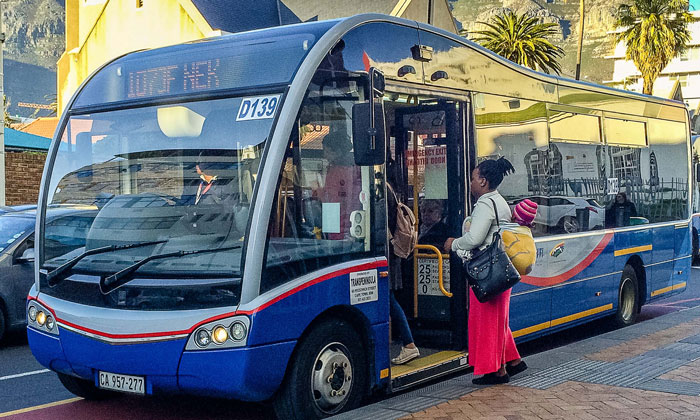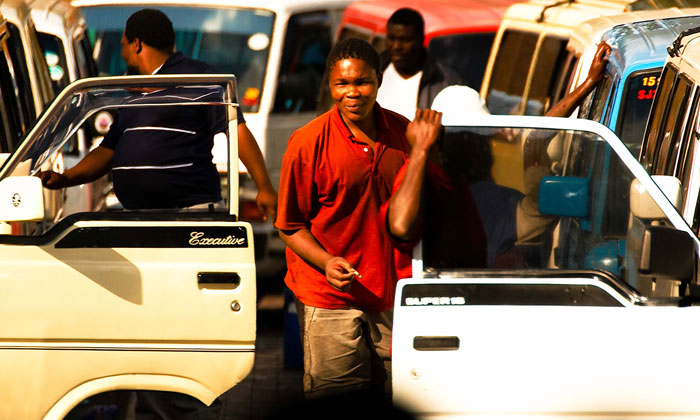Using big data to improve Cape Town’s transport
- Like
- Digg
- Del
- Tumblr
- VKontakte
- Buffer
- Love This
- Odnoklassniki
- Meneame
- Blogger
- Amazon
- Yahoo Mail
- Gmail
- AOL
- Newsvine
- HackerNews
- Evernote
- MySpace
- Mail.ru
- Viadeo
- Line
- Comments
- Yummly
- SMS
- Viber
- Telegram
- Subscribe
- Skype
- Facebook Messenger
- Kakao
- LiveJournal
- Yammer
- Edgar
- Fintel
- Mix
- Instapaper
- Copy Link
Posted: 2 March 2018 | Paul Vorster - ITS South Africa | No comments yet
Big data has many applications worldwide, so harnessing it to improve transport operations in South African cities – and other cities on the continent – hasn’t been lost on transport authorities, ITS engineers and data scientists, explains Dr Paul Vorster, CEO of the Intelligent Transport Society South Africa.


Improving transport operations, such as public transport, private vehicles and the movement of freight, is especially important as major metropolitan areas continue to grow. When these areas grow ‘vertically’ they can achieve higher densities, which benefits public transport operators with increased ridership in closer proximity to transit services. This may also promote non-motorised transport options.
However, when metros grow ‘horizontally’ the distances and levels of congestion – and consequently travel times – increase, along with the number of vehicles on the road.
Metropolitan areas typically expand up and outwards, and must cater for the large number of commuters both in- and out-bound from neighbouring cities and towns. The diverse socio-economic profile of these commuters means that an eclectic collection of often-disjointed transport services is in operation to move people, goods and services into and out of metros.
Metropolitan transport authorities are turning to big data to find ways to improve traffic flow for private and public transport vehicles; plan a more efficient and sustainable transport network; and also to empower travellers and commuters with information to guide optimal mode, route and timing decisions.
Smarter transport is becoming a key driver in creating smart cities and this phenomenon is happening in South African cities, such as Cape Town.
Bustling cities
Well-established cities tend to have more mature transport infrastructure and services compared to that of newer cities, which are fast-growing, face rapid urbanisation and have a challenging task in producing a transport network able to cater for in-bound migration and urban sprawl.
Lagos, Nairobi, Addis Ababa, Dar es Salaam, Maputo, Johannesburg and Cape Town are typical examples of bustling and vibrant cities where the overwhelming majority of commuters rely on public transport dominated by the informal and unregulated minibus and matatu vehicles. Minibus taxis are a distinctly South African phenomenon that arose from the physical separation that occurred during the apartheid era. These services rarely run to a timetable, with vehicles departing when they are full. Routes are mostly spontaneous and stops are wherever they drop passengers or can collect more.
Now, cities like those mentioned above are investing significant resources in improving legacy systems and introducing modern and effective transport solutions.
City of Cape Town
Cape Town has taken a strategic step by establishing the Transport and Urban Development Authority (TDA). The TDA combines the functions of integrated transport, urban development and elements of human settlements into a single governmental body, thereby dramatically improving efficiency and focusing on the spatial transformation of Cape Town.
Using a range of intelligent transport systems (ITS) and big data solutions, the city is setting a high bar for other municipalities and metros regarding how to go about improving mobility.
Two local ITS companies that are both receiving international recognition are developing building blocks to make transport work smarter and help commuters plan their trip from door to door.


Cape Town’s public transit network suffers from fragmentation, but utilising big data can help to close the gap between services
Daunting challenges
Moving around in a bustling city using an informal and unregulated network is hugely challenging and very frustrating. For decades commuters have navigated Cape Town’s informal taxi network of more than 7,500 unregulated minibuses using only word of mouth and learning through trial-and-error.
Devin De Vries, co-Founder of WhereIsMyTransport (WIMT), says that for the first time, this network has been mapped alongside official rail and bus networks by WIMT, a Cape Town-based start-up on a mission to improve emerging cities’ transit systems through big data.
In 2016, WhereIsMyTransport secured an investment of more than $1.5 million to fund a new open information platform that collates transit data for both formal and informal services and combines it with analytics and communication tools. Less than a year later, Cape Town had its formally and informally run transport system data captured, integrated and openly available.
While it only covers the city’s 10 busiest taxi hubs, the map reveals quite a lot about the ‘Mother City’ (as Cape Town is affectionately known). It highlights the fastest route to your destination, exposes underrepresented communities that formal transit doesn’t reach, and lays bare the disparate access to public services that still exists. However, the map’s real significance lies in the data being openly and dynamically available.
Over the course of three weeks, the data collectors captured over 1,000 routes, travelling a total distance of 13,410km. They used mobile tools created to track the routes and to collect important metadata about its operation, during both peak and off-peak times, as well as at weekends. That metadata allows the algorithms to model the taxis’ behaviour, meaning the journey planner can provide estimated times even though the vehicles don’t have a set timetable. WhereIsMyTransport created back-end tools to process the data each day as it came in, validating, cleaning and snapping the coordinates to the actual road network to make sure all the information in the platform is as accurate as possible.
“Every assumption about the network in Cape Town was challenged,” says Graeme Leighton, the Coordinator of the project. “We discovered dozens of previously unknown routes and many documented routes no longer operated.”
Of those 1,000 routes, 657 of them proved to be unique; another important outcome for the team.
Data is verified as it is collected through both human and computational means. Data collectors methodically work through route lists, comparing them to those available at the ranks and discussing all known routes from that rank with the rank managers and drivers. As it is collected, the data is visualised on a map and checked by the collection coordinator for features such as route length, coverage and network density, which includes comparing routes A-B and B-A, confirmed unidirectional routes or unusual frequencies. This method ensures that every route that is active in the city is captured – even low frequency or weekend only routes. Some routes may exist on paper in city registries or licences but are no longer operational; these routes are not reflected in the data.
“Fully mapping Cape Town is a phenomenal achievement for our team,” says De Vries. “We’ve demonstrated that complex transport systems can be mapped at a much lower cost than many cities believe.”
WhereIsMyTransport will continue collecting taxi network data in other South African cities including Port Elizabeth, Durban, Johannesburg, Tshwane, Ekurhuleni and Bloemfontein, and intends to fully map 20 African cities by the end of 2018.
Alongside this they have developed a transport solution which is a platform for smart cities focused on emerging economies. It is a solution for municipalities and operators that connects the informal transport that makes up over 70 per cent of trips in Africa alone, while ‘Findmyway’ – the company’s app for commuters – is available in seven South African cities. With 25 staff working in the Cape Town and London offices, the solution uses machine learning, big data and cutting-edge technology to connect every operator in a city, centralise the data for governments and agencies, and power real-time communication and analytics for more efficient, usable networks.


The City of Cape Town recently invested ZAR750 million to improve road infrastructure and reduce congestion
Another ITS company active in utilising big data, GoMetro, has recently been awarded the Frost & Sullivan prize for International Best Practices in ‘Transportation VAS’.
Getting to work in Cape Town can be frustrating. With the highest levels of traffic congestion in South Africa, according to TomTom, and continuous Metrorail challenges from cable theft and vandalism, commuters’ travel time can almost double during peak hours. This problem is compounded by the complexity of the town’s population growing by 2-3 per cent every year and the fact that public transport is managed by multiple stakeholders. Figures from Cape Town’s Operating License Strategy shows the extent of this complexity1: MyCiTi buses, with 59,184 passengers daily, is managed by the City of Cape Town; Golden Arrow buses, with 230,000 passengers daily, is managed by Golden Arrow; trains, with 634,837 passengers daily, are under the jurisdiction of Metrorail, but with some lines impacted by Transnet; and mini taxi services, with 320,041 passengers daily, are administered by 102 taxi associations. Road traffic constitutes about 1.3 million passengers daily, but what is being done to address congestion and delays, and what technology can be used to help passengers?
GoMetro has developed an app to help commuters plot their journey, which currently has 200,000 active users and 2 million monthly searches linking to buses, trains and mini taxis.
Justin Coetzee, Founder of GoMetro, explains: “The quality of our app will improve when MyCiTi and Metrorail open up their data for real-time bus/train schedules.” Unfortunately, Metrorail has said that their data is managed nationally by the Passenger Rail Agency of South Africa (PRASA), so it has yet to be determined when this will be available.
But apps require data, so what is Cape Town’s plan to ensure free Wi-Fi is available to commuters? The city is distributing public Wi-Fi as part of a wider broadband roll-out programme, which is already underway in taxi ranks. The city is also appointing a supplier to provide Wi-Fi on MyCiTi buses, but as Andre Stelzner, CIO of the City, says: “Providing Wi-Fi on buses is challenging and can be expensive, so it is best justified on routes with high occupancy.”
For road users, the City of Cape Town recently committed ZAR750 million to upgrade road infrastructure projects over the next five years with their initial focus being Kuils River, Kommetjie and Blaauwberg, where travel is on average twice as long during the peak period compared with off-peak. This congestion management programme will also address the worst congested areas in relation to freight movement, business traffic and public transport services. But if Cape Town is 55th on the TomTom Traffic Index, spare a thought for Istanbul who are top of the list where commuters spend almost double the time of Capetonians getting home!
There is a growing realisation in South Africa and in fellow African countries about the power of transport as an enabler and key driver for transformation. The collection of principles behind Mobility-as-a-Service is helping transport authorities and operators to shift the focus away from competing operators on different modes towards a commuter-centric paradigm. The more we can focus on moving people, as opposed to moving vehicles, the quicker we will improve mobility.
Reference
- Operating Licence Strategy, City of Cape Town, July 2013.
Biography


Related topics
Infrastructure & Urban Planning, Passenger Experience
Issue
Issue 1 2018
Related cities
Cape Town, South Africa
Related organisations
ITS South Africa
Related people
Paul Vorster








